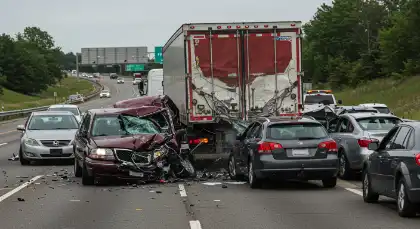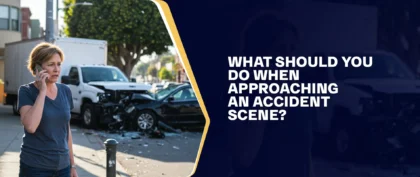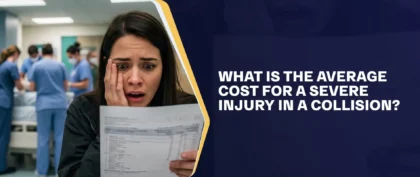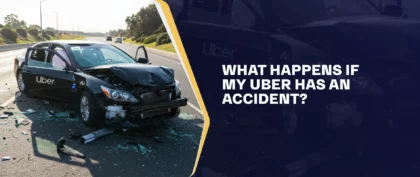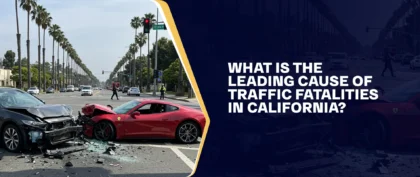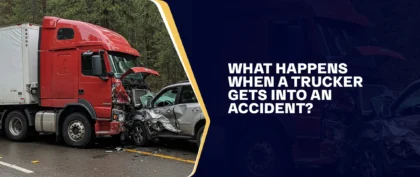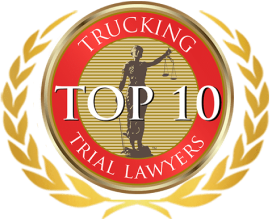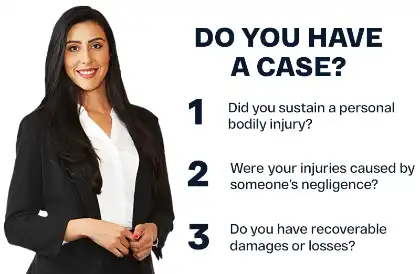Table of Contents
Rear-end collisions with big rigs are among the most dangerous accidents on American roads. The Federal Motor Carrier Safety Administration (FMCSA) reports that in 2021, large trucks were in about 494,000 accidents, with rear-end collisions making up 19.1% of fatal crashes and 24.6% of all injury crashes.
Rear-ending big-rig trucks often happens due to factors like sudden braking, poor visibility, distracted driving, or the unique challenge of underride crashes. The massive size and weight of commercial trucks amplify the severity of these collisions, leading to devastating injuries and financial losses.
Understanding the cause behind these accidents is key to preventing future collisions and ensuring safer roads. If a truck accident has impacted you or a loved one, don’t wait. Call Arash Law at (888) 488-1391 for a free consultation, and let us fight for the justice and compensation you deserve.
Why Do Vehicles Always Rear-End Crash Big Rigs?
Rear-end collisions involving big rigs are frequently attributed to a combination of driver error, equipment malfunctions, and hazardous road conditions. In 2021, studies found that these incidents constituted 29% of all reported crashes, underscoring the ongoing challenges in ensuring safety on our highways.
A specific and more dangerous type of rear-end collision is the underride accident. This occurs when a smaller vehicle, such as a passenger car, crashes into the rear or side of a large truck, like a big rig or 18-wheeler, and slides underneath the truck’s trailer. Underride accidents often happen when the smaller vehicle follows too closely, loses control, or is unable to stop in time.
The consequences of these truck collisions go beyond immediate injuries and property damage, leading to heightened risks for other drivers and road users. However, identifying these causes is essential for prevention strategies and determining liability in accident claims. When victims understand what led to the accident, they can more effectively pursue appropriate compensation for injuries and damages.
Common Causes Of Rear-End Crashes With Big Rigs
Rear-end crashes involving big rigs can have devastating consequences for victims, often resulting in serious injuries and significant financial burdens. Understanding the causes of these incidents is crucial for victims seeking justice and fair compensation. By holding trucking companies and drivers accountable, victims can pursue claims to cover medical expenses, lost wages, and other damages, ensuring their rights are protected while highlighting the importance of safer roadways.
Human Errors That Cause Rear-End Crashes
Many of the most devastating rear-end crashes involving big rigs can be traced back to human behavior behind the wheel. From distracted driving to fatigue-induced mistakes, driver actions often play a pivotal role in how and why these accidents unfold.
Driver Fatigue
Long-haul trucking often makes drivers tired, even with rules on driving hours. Fatigued truck drivers might brake late or miss hazards. This raises risks for everyone on the road. Other drivers can also cause accidents, like rear-end trucks, if they are similarly tired, distracted, or don’t keep a safe distance.
According to the CDC, staying awake for 17 hours can affect your driving like having a 0.05% blood alcohol level. After 24 hours without sleep, it’s like having a 0.10% BAC, which is over the legal limit.
Distracted Driving
Just a second of distraction behind the wheel can cause a serious crash with a big rig. Whether it’s failing to notice the truck slowing down to stop or not maintaining a safe following distance, distracted driving can have life-altering consequences. Distraction affects truck drivers and other drivers alike:
- Commercial vehicle drivers may be distracted by dispatch devices, GPS, or radios.
- Passenger vehicle drivers may be texting, using phones, or rubbernecking near trucks.
These accidents often cause more than just physical harm; they can impact the victims and their families emotionally, financially, and psychologically for years to come.
Following Too Closely
Drivers often don’t realize how much stopping distance is needed when following a truck too closely, also known as tailgating. Because trucks are so large and heavy, they need much more time and space to stop than smaller cars. Many drivers misjudge this and leave too little room to react. If a truck stops suddenly, the car behind it may not have enough time to avoid crashing. This can lead to rear-end accidents that put everyone on the road at risk. To prevent these devastating crashes, always keep a safe distance when driving behind trucks.
Sudden Or Improper Lane Changes
Imagine driving on the highway with a large truck ahead of you. Suddenly, a vehicle cuts in front of it without warning, forcing the driver to brake abruptly. This creates a ripple effect, where the driver behind the truck may not have enough time or space to react, leading to a rear-end collision. In some cases, the following driver may panic and overcorrect by swerving too sharply, which can lead to a crash with the truck or other nearby vehicles. Around 3% of U.S. fatal crashes in 2022 were attributed to overcorrecting.
Overcorrecting is a relatively minor factor in rear-end crashes, accounting for only a small percentage under typical road conditions. However, it is still important to consider, especially when following or operating big rigs, as sudden swerving or panic steering can quickly lead to serious collisions.
These accidents are avoidable by signaling properly and maintaining a safe distance from large vehicles.
Sudden Or Improper Turning
Rear-end collisions can also occur when a driver misjudges a turn or attempts to change lanes too suddenly, especially near large trucks. The size and slower movements of big rigs can make it difficult for other drivers to anticipate their position, increasing the likelihood of a crash.
In one incident, the driver of a Chrysler 300 rear-ended a big rig while attempting to make a turn onto another highway. This suggests the driver may have been too close to the truck or didn’t anticipate the truck’s position during the maneuver. The combination of turning and following too closely likely contributed to the crash.
Brake Checks By Other Vehicles
Sometimes, drivers engage in “brake checking,” a reckless move in which someone suddenly slams on the brakes in front of a truck, often out of frustration or as a form of intimidation.
This irresponsible act can lead to serious consequences. Trucks are larger and heavier, so they need more time and distance to stop than cars. If a truck has to brake hard, it might stop suddenly. This increases the risk of a rear-end collision with vehicles behind it. Such incidents endanger the truck driver and many other road users, risking injuries or fatalities.
Inadequate Driver Training
Lack of training can lead to serious dangers on the road. Truck drivers may brake suddenly, miss warning signs, or have trouble staying in their lane, especially in traffic.
Other drivers may not know how to share the road with big rigs safely. Common mistakes include:
- Following too closely.
- Driving in blind spots.
- Not allowing enough space for wide turns.
With better training for both truck drivers and passenger vehicle drivers, many of these accidents could be avoided. Educating all drivers is key to making roads safer.
Parking On The Side Of Highways
Big rigs often pull over on highways or shoulder areas for breaks, mechanical issues, or to comply with federal regulations that limit driving hours. While this is a necessary safety measure for truck drivers, it can be hazardous for other vehicles. Drivers behind the truck may not notice it in time, particularly if it’s dark, raining, or foggy, or if the truck is parked in an area with poor visibility. If the truck isn’t properly marked with reflective tape or warning lights, it becomes a hidden danger for approaching vehicles.
Many drivers, especially those following too closely, may not realize that the truck is stopped until it’s too late. In these situations, there’s little time for them to react, making rear-end collisions more likely. This risk increases if the parked truck is on a curve or near an exit ramp where vehicles are often changing lanes or slowing down.
Additionally, some drivers may misjudge the distance between their vehicle and a stationary truck, thinking they have more time to react than they actually do. This can lead to sudden, preventable crashes that cause serious injuries or even fatalities.
Proper visibility, clear markings, and ensuring trucks are parked in safe, designated areas can significantly reduce the likelihood of rear-end accidents involving stopped big rigs.
Sudden Medical Emergencies
Rear-end collisions with big rigs aren’t always caused by distraction or reckless driving — sometimes they result from sudden, unexpected medical emergencies. If a driver suffers a heart attack, seizure, or even a diabetic episode behind the wheel, they may lose the ability to control their vehicle entirely. In those critical moments, the driver might be unable to brake or swerve to avoid a stopped or slowing truck, causing a direct rear-end crash.
These incidents are less common than other causes, but they are real and often overlooked. Unlike texting or tailgating, which involve poor judgment, medical events are unintentional and unpredictable. They’re especially dangerous because they leave little or no time for the driver to respond, and trailing drivers may appear at fault unless an investigation reveals the underlying medical cause.
Overreliance On Automation
Drivers using advanced driver-assistance systems (like adaptive cruise control or semi-autonomous “autopilot” features) may fail to monitor the road, assuming the car will stop itself. If the system doesn’t recognize a slow or stopped truck, the vehicle can plow into the rig’s rear without any braking. In such cases, the trailing driver’s trust in technology, rather than direct distraction, is the culprit.
Highway Hypnosis (Zoning Out)
Highway hypnosis, also known as “white line fever,” is a trance-like state that can affect drivers during long, uneventful stretches of road. Even though the driver is technically awake and has their eyes on the road, their mind drifts and their awareness fades. They may lose track of time and fail to process what’s happening around them consciously. This mental fog causes reaction times to slow and makes it easy to miss visual cues, like a big rig semi-truck decelerating or standing still ahead.
Unlike fatigue, where the body feels physically tired, or distraction from a phone or conversation, highway hypnosis is more subtle and passive. It can affect even experienced drivers and tends to occur on straight highways with little traffic variation. A driver under this condition may not realize they need to slow down until it’s too late, often resulting in a rear-end crash with a large truck that seemed to appear out of nowhere. It’s a lesser-known but very real danger, especially on long-distance or overnight drives.
Vehicle-Related Factors In Rear-End Crashes
Not all rear-end truck collisions are caused by human error. Sometimes, the machinery fails us. Faulty parts, inadequate lighting, and blind spots can all compromise safety. These technical issues often go unnoticed until it’s too late.
Blind Spots
Trucks have large blind spots, also called “no-zones,” that significantly affect the safety of nearby vehicles, especially those following too closely. These blind spots are due to the truck’s height, length, and design, which limit the driver’s ability to see around the vehicle.
Key areas of concern include:
- Rear Blind Spot — The area directly behind a truck is hazardous. Truck drivers often cannot see vehicles following too closely.
- Limited Visibility — If you drive in a truck’s blind spot, the driver may not know you’re there.
- Sudden Stops — If a truck needs to slow down or stop quickly, a driver lingering in the truck’s rear blind spot may not see the brake lights in time to react. This increases the risk of a rear-end collision, especially if the driver is following too closely.
- Longer Stopping Distances — Trucks require more time and space to come to a complete stop due to their size and weight. If a smaller vehicle is in a front or side blind spot and suddenly slows down or cuts in, the truck driver may not see them in time to brake safely, leading to a serious crash.
Inadequate Lighting
Lighting conditions are key to seeing big rigs on the road, especially at night, in fog, or during heavy rain. Poor lighting can make it difficult for drivers to spot trucks, especially if they’re slowing down or stopped. This increases the chance of rear-end collisions.
When visibility is low, drivers may not notice a truck in time to react. Dim or malfunctioning headlights on passenger vehicles make it even harder to see trucks ahead, adding to the danger. All drivers need to slow down and stay alert in these conditions to avoid accidents.
Mechanical Issues
Regular vehicle maintenance is crucial, especially for large trucks, as it can prevent accidents like rear-end collisions. However, mechanical issues in the following vehicle can also contribute to these incidents, such as:
- Worn brakes reduce the ability to stop in time.
- Underinflated or damaged tires impact stability and control.
- Faulty headlights make it harder to gauge distance at night or in low-visibility conditions.
Addressing maintenance for all vehicles on the road is essential to improve safety and reduce the risk of collisions.
Improper Cargo Loading
Improperly loaded cargo can significantly impact a truck’s ability to stop or maneuver safely, leading to rear-end accidents. Here’s how:
- Increased Stopping Distance — Overloaded trucks require more time and space to stop. This can prevent the driver from braking in time, leaving trailing vehicles unable to react.
- Reduced Maneuverability — Uneven cargo affects a truck’s balance, making it harder to turn or change lanes. A driver may not anticipate these movements, causing a rear-end crash.
- Risk of Jackknifing — Overloading can cause the trailer to swing uncontrollably, especially during sudden braking, putting trailing vehicles at risk of rear-ending the truck.
- Trailer Sway (Fishtailing) — Shifting cargo can cause the trailer to sway, making the truck unpredictable. The following drivers may misjudge the movement and fail to stop in time.
- Tire Wear And Mechanical Strain — Overloading puts extra strain on tires and brakes, reducing stopping power. If the truck can’t stop quickly, a rear-end collision is more likely.
- Dislodging Cargo — Improperly secured cargo can shift or fall off the truck during sudden stops. Trailing vehicles may not have enough time to avoid the debris.
- Impeded Visibility — Overloaded trucks may have obstructed mirrors, reducing the driver’s ability to see other vehicles, leading to unexpected stops and rear-end crashes.
In short, improper cargo loading impacts stopping distance, truck stability, and visibility, all heightening the risk of rear-end collisions. If this factor contributed to the accident, delivery truck accident lawyers can help gather critical evidence, such as loading logs and safety records, to establish liability and strengthen the case.
Inadequate Warning Signals
Trucks need proper lighting and reflective markings to stay visible to other drivers. When brake lights, taillights, or reflective tape are broken or not working, it’s harder for drivers to see the truck, especially in poor visibility conditions like at night or during rain or fog. Without clear signals, drivers may not notice when a truck slows down or stops suddenly, increasing the chance of a rear-end crash.
For example, a truck with dim or broken brake lights might look like it’s moving at the same speed, causing a driver behind it to misjudge how much time they have to stop. Similarly, if a truck doesn’t have enough reflective tape, drivers might not see it, especially if the truck is parked on the side of the road. Keeping lights and markings in good condition is important to help prevent accidents.
Mandatory Stops Or Slowdowns
Large trucks sometimes must stop or slow down in places where other drivers aren’t prepared for it. For instance, certain trucks have to stop at railroad crossings or weigh stations, or a tractor-trailer might slow down well before a turn or an intersection due to its size and cargo. A trailing motorist unfamiliar with this can be caught off guard by a near-standstill truck on an open road, leading to a rear-end collision simply because the truck’s stop was unexpected.
Slow Merging Or Exiting By Trucks
Big rigs move slowly when merging onto highways or exiting from them because of their size and weight. If a truck enters traffic at a low speed, a fast-approaching driver may misjudge how quickly they’re closing in on the truck and not have enough time to stop. This is especially common on busy California freeways like the I-5 or I-405, where traffic moves quickly and on-ramps are often short, giving trucks limited space to pick up speed before joining fast-moving lanes.
This also happens when a truck slowly pulls out from a driveway, shoulder, or side road. This is common in agricultural or industrial areas like those along Highway 99 in the Central Valley or warehouse-heavy regions near the Port of Los Angeles. In these situations, the truck may seem to appear out of nowhere to a trailing driver, creating a sudden and unexpected obstacle. These low-speed maneuvers often go unnoticed as risk factors but are a real cause of rear-end collisions across California.
Sun Glare And Visibility Illusions
Sun glare is a serious and often underestimated hazard that can directly lead to rear-end collisions with big rigs. When the sun is low on the horizon, typically during sunrise or sunset, it can shine directly into a driver’s line of sight and make it difficult to see brake lights, turn signals, or even the full outline of a truck ahead. According to EHS Today, sun glare contributes to thousands of crashes each year by creating a temporary blindness that reduces a driver’s ability to react to changing traffic conditions. Even a few seconds of reduced visibility can cause a trailing driver to miss the fact that a big rig has slowed or stopped, increasing the chance of a rear-end crash.
In California, sun glare is a common issue on east-west highways such as I-10 and Highway 60 during morning and evening commutes. Drivers heading west in the afternoon or east in the early morning may struggle to see the road clearly, especially if their windshield is dirty or damaged. Reflections off road signs, mirrors, or other vehicles can also make it harder to spot a truck ahead. Although this is not caused by mechanical failure or driver error, it is just as dangerous as driving in fog or heavy rain. When visibility is limited, drivers may misjudge distances or fail to notice a large truck slowing down in time to stop safely. Taking simple steps like using sun visors, keeping windshields clean, and wearing polarized sunglasses can help reduce the risk.
Poor Road Design Or Infrastructure Hazards
Road design flaws and infrastructure issues get overlooked as contributors to rear-end collisions involving big rigs. In California, where traffic density and terrain vary widely, certain features, like sharp curves, steep grades, or short merge lanes, can limit visibility and reduce reaction time.
For example, a driver approaching a steep hill on I-15 through Cajon Pass may not see a slow-moving semi climbing the grade until it’s too late to stop. Similarly, in rural areas or city intersections like those along Highway 152 or I-80, trucks may be stopping at a partially obscured red light or making a slow turn on a narrow curve, giving trailing drivers little warning or space to react.
Sudden braking also occurs when trucks encounter road hazards such as potholes, debris, or uneven pavement. According to the Federal Motor Carrier Safety Administration (FMCSA), road and environmental conditions contributed to 22% of crashes involving large trucks in 2021. A pothole or loose cargo on a poorly maintained stretch of road may force a truck driver to brake or swerve suddenly. These are actions that can easily catch the following driver off guard and lead to a rear-end collision.
These infrastructure-related causes are often noted in official crash reports but receive far less public attention than speeding, distraction, or fatigue. Yet they play a measurable role in many truck-related accidents. Improving signage, increasing visibility around curves and inclines, and keeping roads in good condition are all essential for preventing these types of collisions.
Environment-Related Factors Leading To Rear-End Accidents
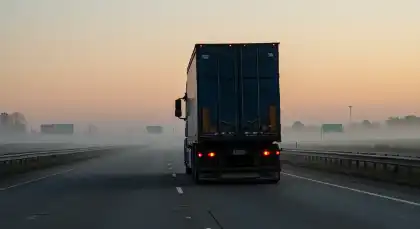
Slippery Roads Due To Rain Or Snow
Slippery roads caused by rain or snow can create dangerous conditions, particularly around big rigs. In California, frequent rainstorms can make roads slick, reducing traction for both trucks and other vehicles. This makes it harder for drivers to stop quickly, increasing the risk of rear-end collisions with big rigs.
Snow and icy conditions, especially in mountainous areas like the Sierra Nevada, worsen these dangers by reducing tire grip and increasing stopping distances. When snow or ice covers roads, it becomes even more challenging to maintain control of a vehicle. Additionally, low visibility during storms, fog, or at dusk or dawn makes it harder for drivers to judge the distance needed to stop behind a truck safely.
In these conditions, drivers need to exercise extra caution, slow down, and leave more space between their vehicles and large trucks to avoid rear-end accidents.
Fogging Or Frosting Of Mirrors
When a truck’s mirrors are fogged up or iced over, the driver may not be able to see vehicles behind them, creating a serious safety risk. This lack of visibility makes it hard to gauge traffic, especially when changing lanes or braking suddenly.
In these conditions, the truck driver might not notice a vehicle tailgating or blocking another vehicle’s path, increasing the chance of a rear-end collision. Drivers need to ensure their mirrors are clear, especially in cold or humid weather, to stay aware of their surroundings and avoid accidents.
Road Debris
Road debris, such as tire fragments, trash, or fallen cargo, poses a serious driver hazard. It can lead to sudden braking or swerving as drivers attempt to avoid hitting the debris, increasing the likelihood of accidents. For example, if a driver isn’t ready for a truck to brake or swerve suddenly, they might crash into it or lose control of their car. This scenario is particularly dangerous at high speeds or in heavy traffic, where reaction times are limited.
Debris can originate from cargo falling from vehicles, blown-out truck tires, and road litter. To tackle this issue, we need proper road maintenance to quickly clear debris. We also need better practices for securing cargo to stop items from falling off. Additionally, raising awareness among drivers can help. When drivers maintain safe distances and stay alert, we can reduce risks from road debris.
Traffic Congestion
Stop-and-go traffic or sudden slowdowns on highways often lead to rear-end crashes, especially when drivers of smaller vehicles fail to react in time or adjust their speed. These situations can be hazardous around big rigs, as their longer stopping distances make it harder for them to avoid collisions when vehicles following behind don’t maintain a safe distance. Recognizing these risks can help drivers stay alert and avoid rear-ending other vehicles, massive rigs, during traffic slowdowns.
Inadequate Road Signs or Warnings
When trucks park in locations without adequate road signs or warning lights, following drivers may not be prepared for a sudden stop or a truck in their path, increasing the chance of a rear-end collision.
Injuries And Trauma Caused By Rear-End Truck Accidents
The injuries sustained in rear-end big rig truck accidents are severe due to the sheer size and weight of big rigs. Their massive size generates a significant force during a collision, which can result in serious trauma to those in smaller vehicles. Big rigs accelerate slowly and take longer to stop, which can catch other drivers off guard. When drivers don’t leave enough space, they may not have time to react, increasing the risk of severe, life-altering injuries in a crash.
Common injuries among accident victims include:
- Traumatic Brain Injuries (TBIs) — Often occur in truck accidents due to violent forces, crushing impacts, or sudden deceleration, which can lead to severe neurological damage.
- Spinal Cord Injuries — These can lead to paralysis or permanent mobility impairment.
- Broken Bones — Fractures to ribs, legs, arms, or the skull are frequent.
- Internal Injuries — Damage to internal organs due to the force of the impact.
- Burns And Lacerations — Contact with burning, sharp, or jagged materials in the accident.
Big-rig accidents can also cause psychological trauma, such as:
- Post-Traumatic Stress Disorder (PTSD) — Anxiety and flashbacks related to the accident.
- Fear of Driving — Many victims develop a lasting aversion to driving post-accident.
In addition, recovering from a rear-end collision with a big rig can be as financially detrimental as it is emotionally and physically painful. Expenses may include:
- Ongoing medical bills and rehabilitation costs.
- Lost wages and diminished earning capacity.
- Property damage and vehicle repair expenses.
You might be wondering, “Do I need a personal injury lawyer to help me with my claim?” The best big rig accident lawyers can help you fight to recover the compensation you need and get back on your feet.
Liability And Legal Considerations In Big Rig Rear-End Accident
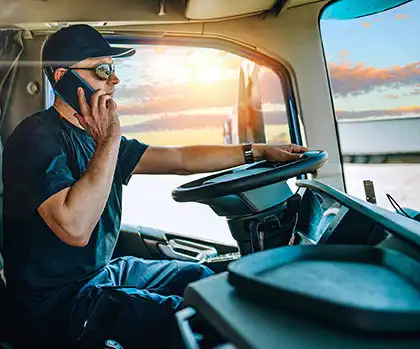
- Truck Driver — If the driver was distracted, speeding, or violating traffic laws.
- The Driver of the Other Vehicle — If they were speeding, distracted, or failed to maintain a safe following distance, they could be found liable for the crash.
- The Trucking Company — If the accident was due to an issue related to truck maintenance or if the driver did not receive proper training, the trucking company may share responsibility.
- The Vehicle Manufacturer — If a defect in the big rig’s equipment, like faulty brakes or lights, contributed to the crash, the manufacturer could be at fault.
- Other Road Users — In some cases, factors like road conditions, poor signage, or improper vehicle lane changes by other drivers may contribute to the accident.
If you were involved in a rear-end collision between a big rig and another vehicle, understanding the nuances of liability can be complex.
Hiring a knowledgeable truck accident attorney is instrumental in collisions involving big rigs, delivery trucks, 18-wheelers, tractor-trailers, or semi-trucks. They can:
- Investigate the accident thoroughly.
- Pursue claims against all liable parties.
- Negotiate with insurance companies.
- Represent you in court if necessary.
Contact Arash Law to discuss your case and ensure your rights are protected.
Frequently Asked Questions About Rear-End Crashes Involving Big Rigs
You asked, we answered. We’ve listed some of the questions injured victims ask our lawyers concerning rear-end accidents with trucks. If you have other questions concerning your case, feel free to call our hotline at (888) 488-1391.
Can A Rear-End Accident Claim Involve Multiple Parties?
A real-world example of shared liability might involve a truck with non-functioning brake lights rear-ended by a momentarily distracted following driver. In such a case, a court might assign 70% liability to the following driver for inattention and 30% to the trucking company for the maintenance failure, with damages adjusted accordingly under comparative negligence principles.
How Can I Stay Safe From Rear-End Accidents?
Always maintain a safe following distance and avoid lingering in a truck’s blind spots. Make sure the truck driver can see you in their side mirrors. If you can’t see the driver, they likely can’t see you. Other prevention strategies truck and car accident lawyers recommend for all road users include:
- Maintaining adequate following distance (minimum 6-8 seconds) behind commercial vehicles.
- Being alert for wide turns and longer stopping distances.
- Avoiding distractions, especially when driving near large commercial vehicles.
- Adjusting driving behavior during adverse weather conditions.
- Understanding and respecting the physical limitations of large vehicles.
What Should I Do After A Rear-End Accident With A Truck?
A rear-end collision with a big rig can leave lasting injuries, financial stress, and a lot of unanswered questions. If you’re no longer at the scene and are now dealing with the aftermath, here’s what you can do to protect your health and legal rights:
-
- Get a Full Medical Evaluation — Even if you walked away from the crash, injuries like whiplash, soft tissue damage, or internal trauma may not show symptoms right away. Visit a doctor as soon as possible if you haven’t already, and follow through on all recommended tests or treatments. Be sure to keep copies of medical records, bills, and prescriptions.
- Document Everything — Write down everything you remember about the crash, including what you were doing, the road conditions, and how the truck hit you. If you took photos of the vehicles, damage, or scene, save them in a safe place. These details will be important for your claim.
- Be Cautious With Insurance Companies — If the at-fault party’s insurer contacts you, don’t feel pressured to talk without legal guidance. Avoid giving recorded statements or accepting quick settlement offers. These payouts are often far less than what you’ll need to cover your treatment, missed work, and long-term effects.
- Call Trusted Truck Accident Lawyers — Truck crashes are complex and involve different rules, evidence, and parties than a typical car accident. A big-rig accident lawyer can investigate your case, deal with the insurance companies, and fight to get you the compensation you deserve. That way, you can focus on your recovery while they handle the legal process.
Rear-End Accident? Talk To Our Big-Rig Accident Lawyers Today.

When accidents happen despite prevention efforts, victims face many challenges in recovery. These cases are complex because they involve federal rules, multiple responsible parties, and serious injuries. This is why expert legal help is so important. If you or a loved one suffered injuries in a collision with a commercial truck, our experienced big-rig accident lawyers can help navigate this challenging process.
As one of the biggest personal injury law firms in California, Arash Law recovered over $750 million for victims, including numerous seven-figure settlements in commercial truck accident cases. We understand these cases’ unique challenges and have the resources to investigate all aspects of your accident thoroughly.
Call Arash Law today at (888) 488-1391 to get free accident lawyer advice. We offer no-obligation consultations to discuss your rights and options. Our compassionate team is ready to help you pursue the full and fair compensation you deserve while you focus on what matters most: your recovery.


